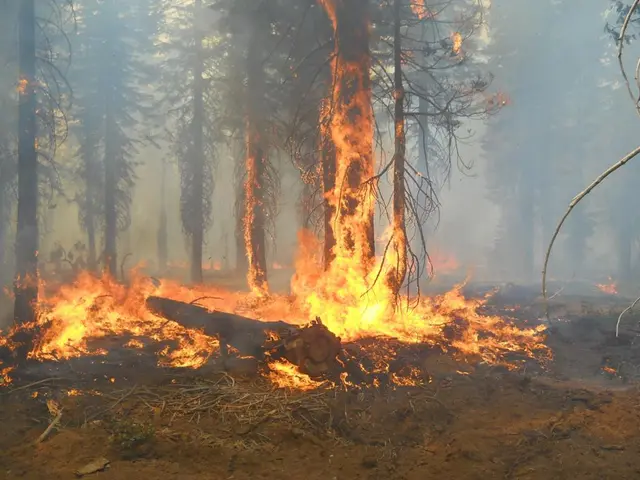Secret Refuges on Aircraft Cabins: Locations Where Flight Crew Members Rest Escaping Prolonged Aviation Journeys
*Chillin' in the Sky's Secret Layered Quarters:*
Aviators cruisin' on long-haul flights ain't got it easy, but they ain't alone in dealin' with the challenges. Modern jetliners got them some pretty sweet secret hideouts, known as the crew rest areas. These bad boys are built specifically for the pilots and ground crew to catch some Zs, and they're hidden pretty well from the average passenger.
Let's take a gander at these hidden dens and all they got to offer.
Why These Nooks Matter
These rest areas are crucial for long voyages, which are typically over eight hours long. Regulations from bodies like the Federal Aviation Administration (FAA) and the European Union Aviation Safety Agency (EASA) demand that airlines provide these spaces to protect against pilot fatigue and keep their game sharp. Fatigue can mess with decision-making and reaction times, which ain't good safety-wise. Rest zones help crew members keep up with those mandated rest periods during their flight duties.
So, Where Are These Zones Found?
Now, the locations vary depending on the type of aircraft, but here are a few examples:
- Up, Up, and Away: Wide-body aircraft, like the Boeing 777 and 787 Dreamliner, often have rest areas above the main cabin, accessible via conveniently placed ladders near the cockpit or kitchen.
- Beneath the Scene: Aircraft such as the Airbus A350 hides these gems below the passenger floor, reachable through clever little hatches.
- Situated in the Cockpit's Shadow: Smaller airplanes or specific designs might place these quarters right behind the cockpit.
The locations are carefully chosen to squeeze every bit of space and minimize interference with passenger areas.
Whatcha Find Inside These Secret Places?
These resting spots are designed to offer maximum comfiness in a small space. Some key features include:
- Beds for Dreams: You'll find 6 to 10 beds, each around 1.98 meters long and 0.76 meters wide, separated for privacy by rolls of fabric.
- Essentials for Sweet Dreams: Each bed comes with a reading light, a storage compartment, hooks, and mirrors. Nifty little extras like blankets, pillows, and sleepwear are often provided too.
- Noise and Temperature Control: Insulation muffles the engine noise, while a climate control system lets crew members choose their desired sleeping temp.
- Safety Measures: Safety precautions like emergency oxygen masks, seatbelts, and communication systems are an essential part of the deal.
Pilots Get Extra Goodies
Pilots have separate, even swankier quarters that are closer to the cockpit. These areas might boast reclining seats and a little washbasin, with some even sportin' a small bathroom. This setup keeps the pilot and cabin crew from resting at the same time, keeping the operation as smooth as possible.
Strict Guidelines to Follow
Aviation regulations division these rest zones into three classes, influencing their design and quality:
- Class 1: Private, enclosed sleeping quarters away from the cockpit and passenger areas, offering complete privacy and limited noise.
- Class 2: Reclining seats or bunks within the cabin, but hidden behind partitions or curtains.
- Class 3: Basic seats with limited recline, used for short breaks on flights where space for Class 1 or 2 facilities ain't available.
The Flightcrew Member Rest Facilities (FAA-Advisory Circular) is just one of the authorities who oversee these rest areas, ensuring they comply with strict safety standards. Access is limited to authorized personnel, and entrances are discreet, keeping secrets from the passengers. Occasionally, curious passengers might be let in on the secret, but that ain't common.
And that's the lowdown on those mysterious sky-bound slumber zones. You might see 'em someday if a crew member happens to give you a tour, but don't hold your breath. For now, just appreciate the unseen spaces that help make your flight as smooth as can be. Wanna learn more? We've got ya covered with resources like [1], [3], [4], and [5]. Keep linin' and learnin'!
- Aviation safety agencies like the Federal Aviation Administration (FAA) and the European Union Aviation Safety Agency (EASA) enforce regulations to ensure crewmembers can safely navigate long-haul flights by providing mandatory rest zones, such as crew rest areas.
- These rest areas, hidden from passengers, are critical for aviation industry professionals to overcome challenges associated with long voyages and maintain their health-and-wellness by catching Zs during mandated rest periods.
- These hidden dens can be found in various locations on aircraft, including above the main cabin, below the passenger floor, or behind the cockpit, designed to minimize interference with passenger areas while maximizing space.
- The finance sector plays a crucial role in the aviation industry, as these rest areas are part of the overall investment in transportation technology and infrastructure to ensure safe and efficient aviation operations.





